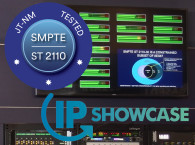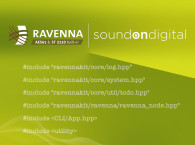A group of leading broadcast equipment and solution suppliers has come together to ensure an easier transition to IP by supporting VSF TR-03/-04, SMPTE 2022-6 and AES67 standards. The newly formed Alliance for IP Media Solutions (AIMS), was born with support from Grass Valley (Belden), Imagine Communications, Lawo and Snell Advanced Media and they already agreed on the audio part, going with AES67.

Lawo, the German manufacturer of IP-based video and audio infrastructure equipment and a promoter of audio networking technologies, including RAVENNA and AES67, has collaborated with other industry suppliers to form the ‘Alliance for IP Media Solutions’ (AIMS). AIMS is organized as an independent trade association founded to ensure that all IP solutions brought to market offer complete interoperability and are based on open standards for seamless integration into media workflow environments. The association’s mission is promoting the adoption, standardization, development and refinement of open protocols for media over IP, with initial focus on VSF TR-03/-04, SMPTE 2022-6 and AES67.
Basically, the aim for AIMS is to promote an industry agreement on standards to support the broadcast television industry transition to IP technologies, leveraging existing technical proposals and standards, away from proprietary solutions which have started to be implemented by some manufacturers. Grass Valley, Imagine Communications, Lawo and Snell Advanced Media have jointly decided to create a new independent trade association with the mandate to bring IP solutions to market that “offer complete interoperability, are based on open standards, and integrate seamlessly into media workflow environments to foster industry innovation and efficiency.”
The group’s efforts will be focused on promoting the adoption, standardization, development and refinement of open protocols for media over IP, with an initial emphasis on VSF TR-03 and TR-04, SMPTE 2022-6 and AES67. “Thanks to the collaborative work already performed in SMPTE, VSF and AES, our industry has built a solid basis for a sustainable transition to IP. AIMS’s support of open standards and technical recommendations such as TR-03, TR-04 and AES67 afford us an opportunity to eliminate the fragmentation of implementations that our industry has endured over the last 20 years. It’s our big chance to avoid repeating expensive and time-consuming mistakes of the past“, says Andreas Hilmer, Director Marketing & Communications with Lawo.
VSF TR-04 is a technical recommendation to use two existing standards: SMPTE 2022-6 for video with embedded audio and AES-67 for separate IP addressable audio streams. In VSF TR-04, AES-67 effectively operates as the “discrete audio” equivalent in IP. AES-67 is already supported by numerous audio companies including Lawo (Ravenna), Riedel, Wheatstone, Audinate (Dante), Yamaha, Axia (LiveWire+), and QSC (Q-Sys). The combination of these two standards into a VSF Technical Recommendation (VSF TR-04) gives the broadcast industry a clear path to separately addressable IP audio in a commercial off-the-shelf (COTS) IP switch that will not require additional conversion from a proprietary IP standard to MADI. With interoperability tests beginning in February of 2016, and with the accessibility of AES-67 technology given as a proven standard, broadcast vendors will be able to start deploying VSF TR-04 systems in the first half of 2016.
Open standards work for the IP transition is already underway by the 74-member Video Services Forum (VSF), with the support of organizations such as the Society of Motion Picture and Television Engineers (SMPTE) and the European Broadcasting Union (EBU). More than 30 broadcast equipment manufacturers are actively testing and validating the VSF’s approach. AIMS provides specific guidance in its bylaws to its members and to the media industry via the AIMS Roadmap.
“We at Lawo have always been aligned to open standards, be it SMPTE 2022-6/-7 and TR-03 in video, AES3, MADI, RAVENNA or AES67 in audio or Ember+ in control. We strongly believe in these standardized, open approaches in order to come to best possible solutions with a solid and secure long-term perspective for our clients”, Hilmer continues.
As broadcasters and other media companies look to use IP workflows to speed and streamline the movement and management of increasingly complex content and adapt their businesses to better compete with other content options such as over-the-top (OTT), open standards are the key to protecting current investments and ensuring long-term interoperability.
“The mission of the Alliance for IP Media Solutions is to endorse open standards and protect the choice that broadcasters and media companies must have when selecting the right solution for their particular needs,” notes Steve Reynolds, CTO, Imagine Communications. Mike Cronk, senior vice president of strategic marketing, Grass Valley, adds, “Our intent is to avoid perpetuating a future where suppliers push their proprietary technologies only to lock media companies into technologies that don’t work well with other systems or are not easily scaled and upgraded.” Tim Thorsteinson, CEO of Snell Advanced Media (SAM) adds, “In this transition to IP, we need one set of standards that become as ubiquitous as SDI (Serial Digital Interface). SAM is throwing its weight behind AIMS because it supports the only set of standards for IP that have been collaboratively developed and that meet the needs of future business models.”
A number of solutions are already on the market to help media companies begin the transition by introducing IP components to an SDI workflow. The transition represents a significant investment and will not happen overnight. An open standards approach allows media companies to implement the technology over time and transition at the pace that makes sense for their businesses. “The rate of change in broadcast and media is unprecedented, so it is critical that the industry rapidly aligns with open standards to the benefit of all—from suppliers to end users,” says Brad Gilmer, executive director of VSF.
Imagine Communications is also collaborating with leading computing and networking leaders, including Arista, Brocade, Cisco, Hewlett Packard Enterprise, IBM and Microsoft, to advance new, open standards-based IP technologies in the IT industry for video production and playout environments. “The foundation of AIMS is the pursuit and acceleration of open standards aligned with the media and entertainment industry,” says Charlie Vogt, CEO, Imagine Communications. “The approach that AIMS is endorsing is already enjoying broad industry support and is well suited to the industry’s future, providing IP’s enhanced flexibility and cost efficiencies by leveraging the huge investments being made in off-the-shelf IT technology.”
Membership in AIMS is available to all individuals and companies that support open standards and share a commitment to the group’s founding principles. The association has published a document detailing “An Argument for Open IP Standards in the Media Industry,” now available online.
www.aimsalliance.org






